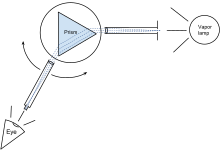Theory
Light is emitted from a source such as a vapor lamp. A slit selects a thin strip of light which passes through the collimator where it gets parallelized. The aligned light then passes through the prism in which it is refracted twice (once when entering and once when leaving). Due to the nature of a dispersive element the angle with which light is refracted depends on its wavelength. This leads to a spectrum of thin lines of light, each being observable at a different angle. A lens or telescope is then used to form images of the original slit, with images formed using different wavelengths of light at different positions. If a real image is formed, it can be recorded on film or an image sensor, making the device a spectrograph.
Replacing the prism with a diffraction grating would result in a grating spectrometer. Optical gratings are less expensive, provide much higher resolution, and are easier to calibrate, due to their linear diffraction dependency. A prism's refraction angle varies nonlinearly with wavelength. On the other hand, gratings have significant intensity losses.
This page is based on this
Wikipedia article Text is available under the
CC BY-SA 4.0 license; additional terms may apply.
Images, videos and audio are available under their respective licenses.


